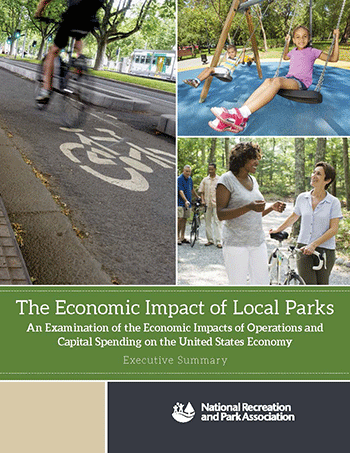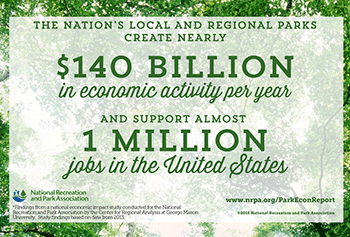 As a park and recreation professional, you already know that public parks are important contributors to the standard of living in our neighborhoods, with benefits spanning from environmental gains and improved health to being a central meeting place that brings residents across ages and social strata to connect to nature. But in a time of scarce resources and tight fiscal budgets, you have to fight for funding to continue your mission.
As a park and recreation professional, you already know that public parks are important contributors to the standard of living in our neighborhoods, with benefits spanning from environmental gains and improved health to being a central meeting place that brings residents across ages and social strata to connect to nature. But in a time of scarce resources and tight fiscal budgets, you have to fight for funding to continue your mission.
With the release of NRPA’s Economic Impact of Local Parks report, you now have resources that show policymakers, stakeholders and community members that public parks are also economic engines to their communities. Specifically, local and regional parks created nearly $140 billion in economic activity and were responsible for nearly 1 million jobs during 2013.
These are great stats that should be shouted from the rooftop, but how do you make it applicable for your agency? Here are five ways to make the report work for you.
 Get the report into the hands of decisionmakers. Show them that park and recreation agencies not only provide the community with essential services, they also contribute economically. Show them that park agencies are not another expense line in a budget. Local and regional parks are contributors to direct, indirect and induced economic activity that resonates throughout the community and the nation as a whole.
Get the report into the hands of decisionmakers. Show them that park and recreation agencies not only provide the community with essential services, they also contribute economically. Show them that park agencies are not another expense line in a budget. Local and regional parks are contributors to direct, indirect and induced economic activity that resonates throughout the community and the nation as a whole. - Beyond the national numbers, share your state’s economic impact amount with local and state elected officials and media who are going to want to know the local impacts. Check out our interactive state charts to get started. Add to this data from your agency (like employment numbers) to find your contribution to the state and national results. Send these data points to local reporters or write an op-ed about the impacts you make. Here is how the Pennsylvania Recreation and Park Society did it.
- Share key data on your personal and agency’s social media accounts. The more eyes that see the value of parks and recreation, the better! Use this image with the key facts on your Facebook, Twitter, Instagram accounts and more. You can also your state’s economic impact numbers to your agency’s website.

- Use the study’s findings to warn of the ripple effects of budget cutbacks. There is a direct relationship between park spending and local employment numbers and economic activity. Explain to local leaders how a cut to park spending could be felt outside the borders of the parks. Budget cuts could result in a reduction of jobs not only from impacted agency employees, but further down the line with agency vendors.
- Know your park. While the national Economic Impact of Local Parks study is a great resource and starting point to demonstrate the economic benefits of parks and recreation, your numbers can be made even more powerful by counting factors the study did not include. Take a look at the other ways your park and recreation facilities contribute to the economy beyond operations and capital expenditures. You may look at visitor spending, increased property values, tourism, reduced medical costs and more.
We’d love to hear how your agency has or will use this report to tell your own story. Share your successes and ideas in the comments or with us on Twitter, Facebook and Instagram.
Melissa May is NRPA’s Research Specialist.

